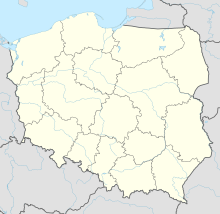Morasko (meteorite)
Coordinates: 52 ° 29 ′ 25 ″ N , 16 ° 53 ′ 47 ″ E
The Morasko meteorite was discovered on November 12, 1914 - shortly after the start of the First World War - near the village of Morasko, about 10 km north of Posen (now Poznań in Poland ).
While digging a gun emplacement, a German NCO came across a lump of metal weighing 77.5 kg about half a meter below the surface of the earth. A sample analyzed in Berlin showed that it was meteoritic material with an iron content of 92%.
In the period that followed, further fragments with a total weight of approx. 350 kg were found in the area. A single piece weighing 92 kg is in the Geological Institute of the Academy of Sciences in Warsaw . The largest single item was found in 2006 and weighs 164 kg.
The pools and pits around were, however, as only in the 1960s crater identified in the impact ( impact ) arising from Meteoroidenbruchstücken. The stray field consists of 8 craters with a diameter of 5 to 100 meters.
The impact probably took place 5,000 years ago. At that time a massive celestial body raced over what is now Poland, evaporated for the most part and was severely slowed down. A remnant piece weighing approx. 200 t shattered at a low height above the ground in a large pressure wave . The fragments then hit the earth's surface at a residual speed of 11,000 to 18,000 km / h.
The original meteoroid comes from the asteroid belt . The meteoritic remainder is classified as a group IIICD coarse octahedrite . Chemical composition: 92% iron ; 7% nickel ; 500 ppm germanium ; 100 ppm gallium ; 1 ppm iridium .
See also
Web links
- Morasko in the Earth Impact Database
- Posen's extraterrestrial suburb . ( Memento from April 19, 2005 in the Internet Archive ) In: Wiener Zeitung .

